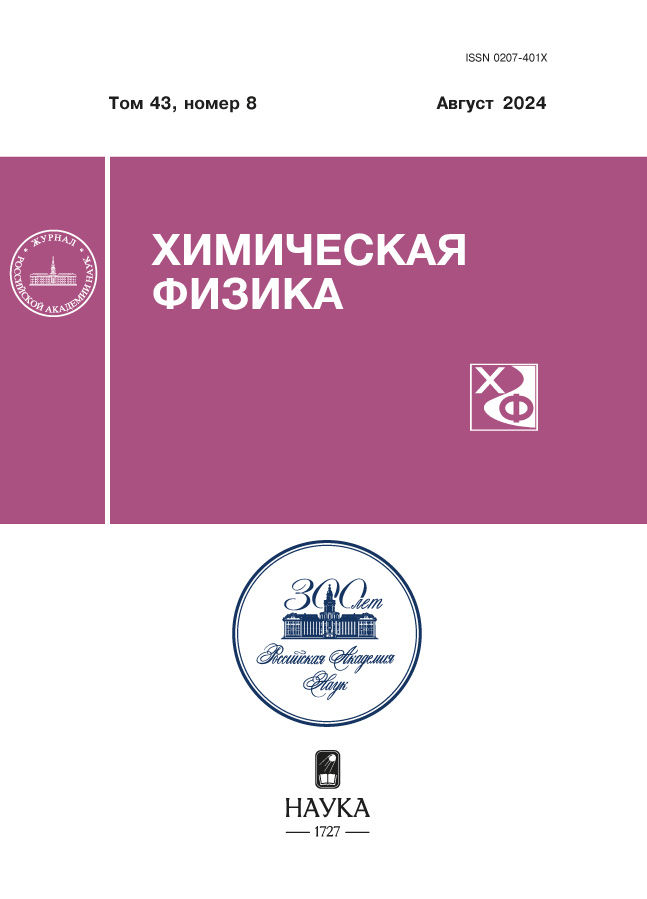Features of the inhibition of hydrogen–air mixtures by propylene additive
- Authors: Belyaev A.A.1, Ermolaev B.S.1
-
Affiliations:
- Semenov Federal Research Center for Chemical Physics of the Russian Academy of Sciences
- Issue: Vol 43, No 8 (2024)
- Pages: 10-23
- Section: Combustion, explosion and shock waves
- URL: https://cijournal.ru/0207-401X/article/view/681880
- DOI: https://doi.org/10.31857/S0207401X24080023
- ID: 681880
Cite item
Abstract
Small additions of hydrocarbons, such as propylene, which are widely studied as combustion and explosion inhibitors of hydrogen–air mixtures, are very specific objects. The known mechanism of the inhibitory effect of these additives is associated with the intensification of the termination of branching chains due to the addition of hydrogen atoms; but also such conditions exist in which these compounds, instead of inhibiting, have a neutral and even promoting effect. Such conditions, as well as the reasons leading to the fact that inhibition is practically absent, have not yet been studied. This article shows the results of numerical modeling, which make it possible to more fully outline the range of conditions where the addition of propylene practically does not inhibit hydrogen-air mixtures and outline possible reasons for this effect. Calculations were carried out with the detailed kinetic mechanism of chemical reactions NUIGMech 1.1 (2020). The objects of the study were three air mixtures containing hydrogen in amounts of 15, 29.6 and 50 vol. % (lean, stoichiometric and rich mixture, respectively) without additives and with 1% addition of propylene.
Full Text
About the authors
A. A. Belyaev
Semenov Federal Research Center for Chemical Physics of the Russian Academy of Sciences
Author for correspondence.
Email: belyaevIHF@yandex.ru
Russian Federation, Moscow
B. S. Ermolaev
Semenov Federal Research Center for Chemical Physics of the Russian Academy of Sciences
Email: belyaevIHF@yandex.ru
Russian Federation, Moscow
References
- V.V. Azatyan, Chain reactions of combustion, explosion and detonation in gases. Chemical control methods (RAS Publs., Moscow, 2020) [in Russian].
- V.V. Azatyan, Chain reactions in the processes of combustion, explosion and detonation of gases (RAS Publs., Chernogolovka, 2017) [in Russian].
- V.A. Bunev, T.A. Bolshova, V.S. Babkin, Combustion, Explosion and Shock Waves, 52 (3), 255 (2016). https://doi.org/10.1134/S0010508216030011
- V.V. Azatyan, A.A. Borisov, A.G. Merzhanov, V.I. Kalachev, V.V. Masalova, A.E. Mailkov, K.Ya. Troshin, Combustion, Explosion and Shock Waves, 41 (1), 1, (2005).
- V.V. Azatyan, S.N. Medvedev, S.M. Frolov, Russian Journal of Physical Chemistry B 4 (2), 300 (2010). https://doi.org/10.1134/S199079311002017X
- N.N. Smirnov, V.F. Nikitin, E.V. Mikhalchenko, L.I. Stamov, Combustion, Explosion and Shock Waves, 58 (5), 564 (2022). https://doi.org/10.1134/S0010508222050082
- N.N. Smirnov, V.V. Azatyan, V.F. Nikitin, E.V. Mikhalchenko, M.N. Smirnova, L.I. Stamov, V.V. Tyurenkova, Int. Journal of Hydrogen Energy, 49, 1315 (2024). https://doi.org/10.1016/j.ijhydene.2023.11.085
- V.V. Azatyan, D.I. Baklanov, I.S. Gordopolova, S.K. Abramov, A.A. Piloyan, The Proc. the Russ. Acad. of Sci., 415 (2), 210 (2007).
- V.V. Zamashchikov, V.A. Bunev, Combustion, Explosion and Shock Waves, 37 (4), 378 (2001).
- A.A. Belyaev, B.S. Ermolaev, I.S. Gordopolova, Gorenie I Vzryv, 17 (1), 27 (2024). https://doi.org/10.30826/CE24170103
- ANSYS Academic Research CFD. CHEMKIN-Pro 15112. San Diego, CA, USA: Reaction Design, 2011. CK-TUT-10112-1112-UG-1.
- A.A. Belyaev, B.S. Ermolaev, Gorenie I Vzryv, 15 (3), 3 (2022). https://doi.org/10.30826/CE
- NUIGMech1.1. National University of Ireland Galway, 2020. https://www.universityofgalway.ie/combustionchemistrycentre/mechanismdownloads/
- V.S. Arutyunov, A.V. Arutyunov, A.A. Belyaev, K.Ya. Troshin, Russ. Chem. Rev., 92 (7), RCR5084 (2023). https://doi.org/10.59761/RCR5084
- A.S. Palankoeva, A.A. Belyaev, V.S. Arutyunov, Russian Journal of Physical Chemistry B 16 (3), 399 (2022). https://doi.org/10.1134/S1990793122030204
- S.D. Arsentev, L.A. Tavadyan, M.G. Bryukov, A.S. Palankoeva, A.A. Belyaev, V.S. Arutyunov, Russian Journal of Physical Chemistry B 16 (6), 1019 (2022). https://doi.org/10.1134/S1990793122060021
- I.N. Momtchiloff, E.D. Taback, R.F. Buswell, Proc. Comb. Inst., 9, 220 (1963).
- M. Slack, A. Grillo, Investigation of hydrogen-air ignition sensitized by nitric oxide and by nitrogen oxide, NASA Report CR-2896 (1977).
- V.V. Azatyan, Kinetics and Catalysis, 61 (3), 736, (2020). https://doi.org/10.1134/S0023158420030039
- A.E. Dahoe, Journal of Loss Prevention in the Process Industries, 18 (3), 152 (2005). https://doi.org/10.1016/j.jlp.2005.03.007
- B.E. Gel’fand, O.E. Popov, B.B. Chayvanov, Hydrogen: combustion and explosion parameters (Fizmatlit, Moscow, 2008) [in Russian].
- A.M. Tereza, G.L. Agafonov, E.K. Anderzhanov, A.S. Betev, S.P. Medvedev, V.N. Mikhalkin, S.V. Khomik, T.T. Cherepanova, Russian Journal of Physical Chemistry B 17 (6), 1294 (2023). https://doi.org/10.1134/S1990793123060246
- V.A. Bunev, V.S. Babkin, Mendeleev Commun., 16 (2), 104 (2006). https://doi.org/10.1070/MC2006v016n02ABEH002270
- A.M. Tereza, G.L. Agafonov, E.K. Anderzhanov, A.S. Betev, S.P. Medvedev, S.V. Khomik, T.T. Cherepanova, Russian Journal of Physical Chemistry B 17 (4), 974 (2023). https://doi.org/10.1134/S1990793123040309
- Ya. B. Zel’dovich, JETP, 9 (12), 1530 (1939).
- Ya.B. Zel’dovich, G.I. Barenblatt, V.B. Librovich, G.M. Makhviladze, The mathematical theory of combustion and explosions (Nauka, Moscow, 1980) [in Russian].
- L.R. Boeck, M. Meijers, A. Kink, R. Mevel, J.E. Shepherd, Combustion and Flame, 185, 265 (2017). https://doi.org/10.1016/j.combustflame.2017.07.007
- S.S. Kutateladze, Heat transfer and hydrodynamic resistance (Energoatomizdat, Moscow, 1990) [in Russian].
Supplementary files




















